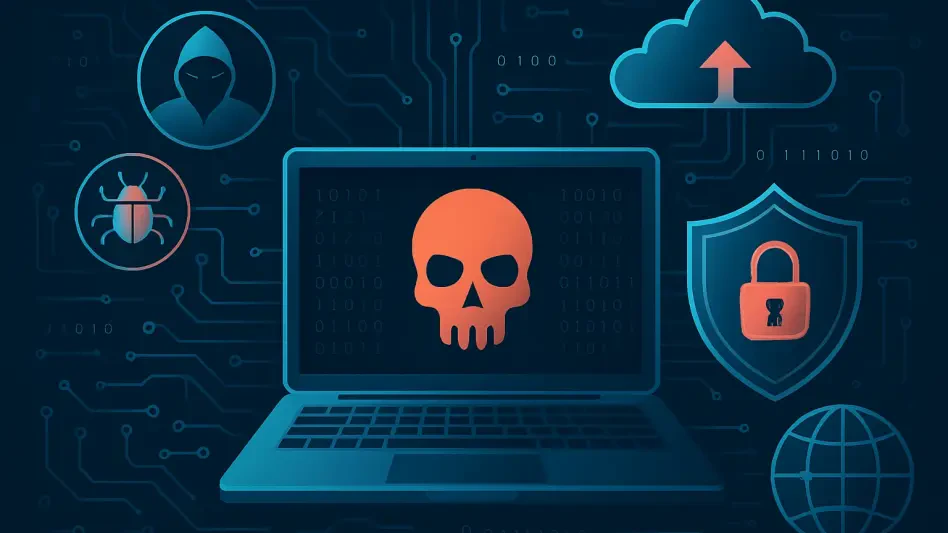In an era where digital landscapes are under constant siege, the nature of cyberattacks has evolved from isolated incidents into highly coordinated, large-scale campaigns that target multiple organizations with startling precision and shared tactics. This alarming trend places immense pressure on businesses to stay ahead of threats, as a single breach can spiral into catastrophic financial and reputational damage. Threat intelligence stands out as a vital lifeline, offering an early warning system that empowers security teams with real-time insights to detect and neutralize dangers before they can inflict harm. By tapping into this powerful resource, companies can shift from a reactive stance to a proactive defense, ensuring they are not caught off guard by the sophisticated maneuvers of modern cybercriminals. The ability to anticipate attacks through actionable data is no longer a luxury but a necessity in safeguarding critical assets against an ever-evolving threat landscape.
Understanding the Cyber Threat Landscape
Escalating Sophistication of Attacks
The complexity of cyberattacks has reached unprecedented levels, with adversaries employing advanced tactics, techniques, and procedures (TTPs) to exploit vulnerabilities across entire industries. These are not random strikes but meticulously planned operations that often target multiple entities with similar weaknesses, amplifying the potential for widespread disruption. By the time a threat manifests within a specific organization, it’s highly probable that others have already encountered a variant of the same attack. This pattern highlights a critical window for preemptive action, where access to real-time threat intelligence can reveal shared attack signatures and enable timely countermeasures. Relying solely on reactive strategies is no longer viable; the speed and scale of these coordinated efforts demand a forward-thinking approach to cybersecurity that prioritizes early detection and rapid response to mitigate risks before they escalate into full-blown crises.
Another dimension of this escalating threat is the sheer ingenuity of attackers in adapting to traditional defenses, often staying one step ahead of conventional security measures. Cybercriminals continuously refine their methods, leveraging automation and artificial intelligence to scale their campaigns and bypass outdated safeguards. This relentless innovation underscores the urgent need for organizations to integrate threat intelligence into their security frameworks, as it provides a dynamic view of emerging dangers and attacker behaviors. Such intelligence not only flags known threats but also uncovers patterns that might indicate the next wave of attacks, allowing security teams to fortify their systems against vulnerabilities that have yet to be exploited. The shift toward understanding the broader threat landscape through shared data is essential for staying competitive in a digital environment where attackers exploit the slightest oversight with devastating precision.
Growing Interconnectivity of Threats
The interconnected nature of modern digital ecosystems has further amplified the reach and impact of cyberattacks, as a breach in one organization can ripple across supply chains and partner networks. Threat actors capitalize on this web of dependencies, targeting weaker links to gain access to larger, more secure entities through lateral movement. Threat intelligence plays a pivotal role in mapping these connections, offering visibility into how an attack on a seemingly unrelated entity could pose a risk downstream. This broader perspective enables security professionals to anticipate potential entry points and reinforce defenses where they are most needed, preventing cascading failures that could cripple entire industries. Without such foresight, businesses remain blind to the indirect threats that loom just beyond their immediate perimeter, making comprehensive intelligence a cornerstone of resilient cybersecurity.
Moreover, the rise of collaborative attack campaigns, where multiple threat groups share tools and intelligence, has created a formidable adversary that operates with alarming efficiency. These alliances often result in synchronized attacks that exploit the same vulnerabilities across diverse sectors, from finance to healthcare. Threat intelligence counters this by fostering a collaborative defense, aggregating data from various sources to provide a unified view of these orchestrated efforts. Security teams can then identify common indicators of compromise (IOCs) and adapt their strategies to address not just individual threats but entire attack frameworks. This collective approach transforms isolated defense mechanisms into a networked shield, significantly reducing the likelihood of falling victim to the next big campaign that sweeps through the digital landscape with ruthless intent.
The Power of Threat Intelligence
Proactive Defense and Contextual Insights
Threat intelligence transcends mere threat identification by delivering deep contextual insights that illuminate the nature and evolution of cyber risks. It equips security teams with critical data such as IOCs, behavioral patterns of malware, and even attribution details about threat actors behind specific campaigns. This richer understanding allows for the development of targeted response strategies that address not only the immediate danger but also the underlying mechanisms driving it. For instance, knowing how a particular threat operates over time can help predict its next move, enabling organizations to reinforce specific defenses before an attack materializes. This level of foresight is indispensable in a landscape where threats mutate rapidly, often outpacing traditional security tools that lack the depth to analyze beyond surface-level indicators.
Additionally, the actionable nature of threat intelligence ensures that security operations centers (SOCs) are not overwhelmed by raw data but instead receive curated, relevant information tailored to their unique environments. This refined approach minimizes false positives and focuses efforts on genuine risks, enhancing overall efficiency. Beyond just technical details, intelligence often provides strategic context, such as the likely targets or motivations of attackers, which can inform broader risk management decisions. By integrating these insights into daily operations, organizations can build a layered defense that adapts to new challenges as they emerge, rather than scrambling to react after damage has already been done. The ability to anticipate and contextualize threats fundamentally changes the game, positioning companies to maintain control over their digital assets against even the most sophisticated adversaries.
Practical Tools for Threat Detection
Specialized tools designed for threat intelligence, such as advanced lookup services, exemplify how technology can translate complex data into immediate, actionable outcomes for security teams. These platforms offer a range of capabilities, from free access to essential threat data for smaller organizations to premium features like automation, API integration, and extensive indicator types for larger enterprises. A suspicious IP address flagged in system logs, for example, can be cross-referenced instantly to uncover links to known malware strains, complete with associated ports and behavioral insights. Such tools drastically cut down the mean time to respond (MTTR), empowering analysts to make informed decisions without wading through endless manual research. The accessibility of these solutions ensures that organizations of all sizes can leverage cutting-edge intelligence to bolster their defenses.
Furthermore, the real-world impact of these tools becomes evident in scenarios where specific threats are identified and neutralized before they can cause harm. Consider a case where a mutex search reveals ties to a remote access trojan, providing not just confirmation of malice but also detailed context about its operations and related IOCs. This granular intelligence allows security professionals to assess the severity of the threat and deploy precise countermeasures, such as blocking specific communication channels or updating endpoint protections. By integrating such tools into existing workflows, SOCs can streamline their processes, reduce analyst fatigue, and maintain a sharper focus on high-priority risks. The practical utility of threat intelligence platforms lies in their ability to transform abstract data into concrete steps that safeguard critical systems with speed and accuracy.
Building a Proactive Cybersecurity Strategy
From Reaction to Anticipation
The transition from a reactive to a proactive cybersecurity posture is a defining advantage of leveraging threat intelligence, as it enables organizations to stay ahead of emerging dangers rather than merely responding to them. Features like subscription-based updates for specific threat queries ensure that security systems are continuously fed with the latest IOCs, often before a direct attack occurs. For instance, tracking malicious domains associated with known malware families allows companies to block potential threats at the network level long before they reach endpoints. This anticipatory approach shrinks the window of vulnerability, giving defenders a crucial edge in a landscape where attackers rely on speed and surprise. Shifting the focus to prevention rather than remediation marks a significant evolution in how digital risks are managed.
Equally important is the cultural shift within organizations that threat intelligence fosters, encouraging a mindset of constant vigilance and preparedness over complacency. Security teams equipped with real-time data become more attuned to subtle signs of impending threats, such as unusual traffic patterns or early indicators of phishing campaigns. This heightened awareness, supported by automated alerts and intelligence feeds, transforms SOCs into proactive hubs that actively hunt for risks rather than waiting for alarms to sound. By embedding anticipation into the core of cybersecurity operations, businesses can disrupt the attack lifecycle at its earliest stages, preventing minor incidents from escalating into major breaches. This forward-looking strategy is essential for maintaining resilience against adversaries who are always probing for the next exploitable gap.
Business Benefits of Threat Intelligence
Beyond its technical merits, threat intelligence delivers substantial business value by minimizing the financial and operational fallout from cyber incidents. Reducing dwell time—the period a threat lingers undetected—directly correlates with less damage, as quicker detection limits the opportunity for data theft or system compromise. This efficiency also translates into cost savings, as resources are not wasted on prolonged incident response or recovery efforts. Furthermore, by providing a clearer picture of the threat landscape, intelligence enables more informed security investments, ensuring budgets are allocated to address the most pressing risks rather than speculative or outdated concerns. These tangible outcomes underscore the strategic importance of threat intelligence in protecting not just systems but also the bottom line.
Another critical advantage lies in the enhanced productivity of security analysts, who benefit from streamlined workflows and reduced manual workloads through the integration of intelligence tools. Instead of sifting through disparate sources for threat data, analysts can rely on centralized platforms that deliver curated insights, allowing them to focus on high-value tasks like threat hunting and strategy development. This boost in efficiency not only improves morale but also strengthens the overall security posture by ensuring that human expertise is applied where it matters most. Additionally, the comprehensive understanding gained from threat intelligence supports better decision-making at the executive level, aligning cybersecurity efforts with broader business goals. As a result, organizations can navigate the digital realm with greater confidence, knowing their defenses are both robust and resource-efficient.
Looking Ahead to Stronger Defenses
Reflecting on the journey through the evolving cyber threat landscape, it becomes evident that threat intelligence has reshaped how organizations tackle digital risks. Its role in providing early warnings and deep contextual insights has proven instrumental in thwarting sophisticated attacks that once seemed unstoppable. Tools designed for real-time threat detection have empowered security teams to act with precision, while proactive strategies have reduced the devastating impact of breaches. The business advantages, from cost reductions to smarter investments, highlight its value beyond the technical realm. Moving forward, the focus should shift to integrating threat intelligence more deeply into existing systems, ensuring seamless automation and broader adoption across industries. Exploring partnerships for intelligence-sharing could further amplify defenses, creating a united front against coordinated threats. By prioritizing these next steps, companies can build a future where cyber resilience is not just a goal but a sustained reality.








